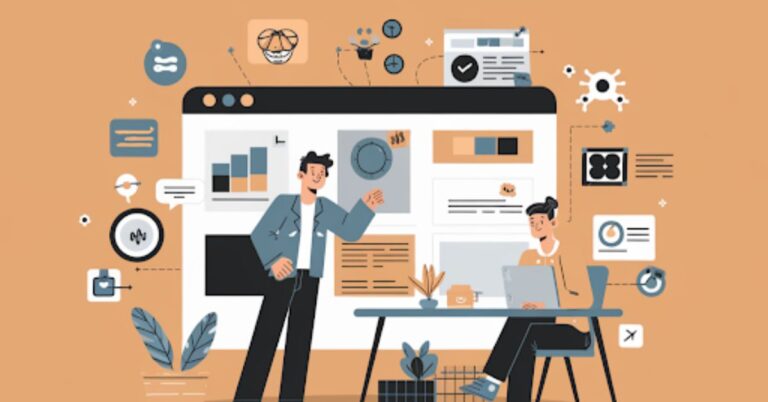Introduction
In today’s digital landscape, a well-designed website is crucial for businesses aiming to establish a strong online presence. It not only reflects your brand’s identity but also plays a pivotal role in attracting and retaining customers. Understanding the importance of web design and the associated costs can help businesses make informed decisions in a competitive market.
The First Impression Matters: Why Web Design Sets the Tone
Your website often serves as the first point of contact between your business and potential customers. A visually appealing and user-friendly design can create a positive first impression, encouraging visitors to explore further. Conversely, a poorly designed website may deter users, leading to lost opportunities.
The Role of Web Design in Building Brand Identity
Consistent and strategic web design reinforces your brand’s identity. Elements like color schemes, typography, and imagery should align with your brand values, creating a cohesive experience that resonates with your target audience.
How Great Web Design Drives User Engagement
Effective web design facilitates easy navigation, clear calls-to-action, and engaging content layouts. These factors contribute to longer visit durations and higher interaction rates, ultimately leading to increased conversions.
Mobile-First Design: Why It’s No Longer Optional
With the majority of users accessing websites via mobile devices, adopting a mobile-first design approach is essential. Responsive designs ensure that your website functions seamlessly across various screen sizes, enhancing user experience and accessibility.
Speed, Structure, and Style: The Technical Side of Web Design
Website performance, including loading speed and structural integrity, significantly impacts user satisfaction and search engine rankings. Optimizing images, leveraging efficient coding practices, and maintaining a clean layout contribute to a technically sound website.
SEO and Web Design: How They Work Together for Visibility
Search Engine Optimization (SEO) and web design are interconnected. A well-structured website with optimized content and metadata enhances visibility on search engines, driving organic traffic and improving online presence.
Trust and Credibility: How Design Influences Customer Confidence
Professional and polished web design instills trust in visitors. Features like secure payment gateways, clear contact information, and testimonials contribute to building credibility and encouraging user engagement.
Conversion Rates and Design: Turning Visitors Into Customers
Strategic placement of elements like call-to-action buttons, intuitive navigation, and persuasive content can guide visitors through the sales funnel, increasing the likelihood of conversions and achieving business goals.
How Poor Web Design Can Hurt Your Business
Neglecting web design can lead to high bounce rates, low engagement, and diminished trust. An outdated or cluttered website may convey a lack of professionalism, potentially driving customers to competitors.
Why Web Design is a Strategic Investment, Not Just an Expense
Investing in quality web design yields long-term benefits, including enhanced brand perception, increased traffic, and higher conversion rates. Viewing web design as a strategic investment rather than a mere expense can lead to substantial returns.
The Hidden Costs of Bad Design: What You Risk by Cutting Corners
Opting for cheap or template-based designs may result in hidden costs such as frequent maintenance, security vulnerabilities, and lost revenue due to poor user experience. Prioritizing quality design can mitigate these risks.
What Influences the Cost of Web Design?
Several factors affect web design costs, including project complexity, number of pages, custom functionalities, and integration requirements. Understanding these variables helps in budgeting effectively.
Freelancer, Agency, or In-House: Which Option Suits Your Budget and Goals?
Choosing between freelancers, agencies, or in-house teams depends on your project’s scope, budget, and desired expertise. Agencies like Odyssey Design Co. offer comprehensive packages catering to diverse business needs.
Breaking Down Web Design Costs by Features and Functionality
Website design packages are comprehensive and include essential features such as mobile-friendly layouts, SEO optimization, search engine submissions, and RSS feed creation. These elements work together to ensure your website not only looks visually appealing but also reaches and engages the right audience effectively.
- Basic Startup Package: Starting at $3,500, includes 3-4 pages, mobile-friendly design, SEO optimization, and forms integration.
- Professional Growth Package: Starting at $6,500, adds advanced forms, Google Analytics integration, optimized loading speed, and one year of shared hosting.
- Premium E-commerce Starter: Starting at $9,500, includes e-commerce integration, up to 20 products, payment gateway integration, and basic training for e-commerce management.
- Ultra-Premium Custom Package: Starting at $15,000+, offers custom Figma designs, enhanced e-commerce features, CRM integration, blog setup, and advanced animations.
How Much Should Web Design Cost for a Startup vs. an Enterprise?
Startups may opt for basic packages to establish an online presence, while enterprises might require custom solutions with advanced features. Aligning the package with business goals ensures optimal investment.
Custom Design vs. Templates: Which One Delivers Better Value?
Custom designs offer tailored solutions that align with brand identity and user needs, providing better long-term value. Templates may be cost-effective initially but could limit scalability and uniqueness.
How to Budget for Web Design in a Competitive Industry
Assess your business objectives, target audience, and required functionalities. Allocate funds for design, development, maintenance, and potential future enhancements to stay competitive.
Red Flags to Watch for When Pricing Web Design Services
Be cautious of unusually low prices, lack of clear deliverables, or absence of a portfolio. Transparent communication and detailed proposals are indicators of reliable service providers.
Why Ongoing Maintenance and Support Should Be Part of the Cost
Continuous maintenance ensures your website remains secure, up-to-date, and functional. Including support services in your budget helps in addressing issues promptly and maintaining performance.
Future-Proofing Your Website: Why Design Is a Long-Term Game
Investing in scalable and adaptable designs prepares your website for future technological advancements and changing user expectations, ensuring longevity and relevance.
Case Studies: Businesses That Thrived with Smart Web Design
Numerous businesses have experienced growth by investing in professional web design, leading to increased traffic, improved user engagement, and higher conversion rates.
Conclusion
Understanding the significance of web design and its associated costs empowers businesses to make informed decisions. Investing in quality design not only enhances user experience but also contributes to achieving long-term business objectives in a competitive market.

